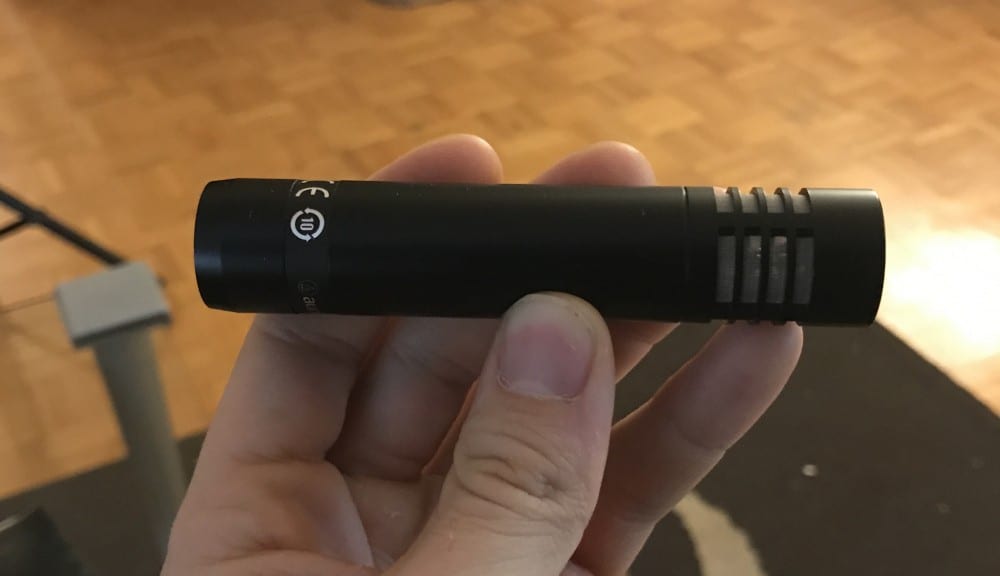Dynamic, condenser, and ribbon microphones are different in three fundamental ways: their transducer, their frequency response, and their directional pattern. Condenser mics, for example, commonly have a side-address polar pattern, a higher frequency response, and a capacitor. You may be wondering what all of this means and more importantly, how these differences affect the condenser mic’s purpose.
Condenser microphones are often used in the studio when details, fast transients, and accuracy are more important. Because of their lightweight membrane, condenser mics are more sensitive to sound, making them ideal for recording vocals, acoustic guitars, drum overheads, and brass instruments.
To put it simply, condenser mics are more sensitive and are used for situations where sensitivity is needed. With that said, this is just a general summary. There are condenser mics that are more apt for live performances or for situations where it would be more common for a dynamic mic to be used. Additionally, there are entirely different types of condenser microphones as well.
When to Use a Condenser Microphone?
As I just mentioned, there are many different condenser microphones on the market (I’ve talked about my favourite before), however, the two fundamental and most common types are the small-diaphragm and the large-diaphragm condenser mics.
They look totally different and are used for separate occasions as well. In addition, to exploring the two main types of condenser mics, we’ll also talk about when to use them.
The Difference Between Small Diaphragm and Large Diaphragm Microphones
To put it simply, small diaphragm condenser microphones are much thinner, smaller, end-fired, and pencil-shaped, whereas large diaphragm condenser mics are bigger and side-addressed. You can see the difference between large and small-diaphragm condenser mics in the image below:
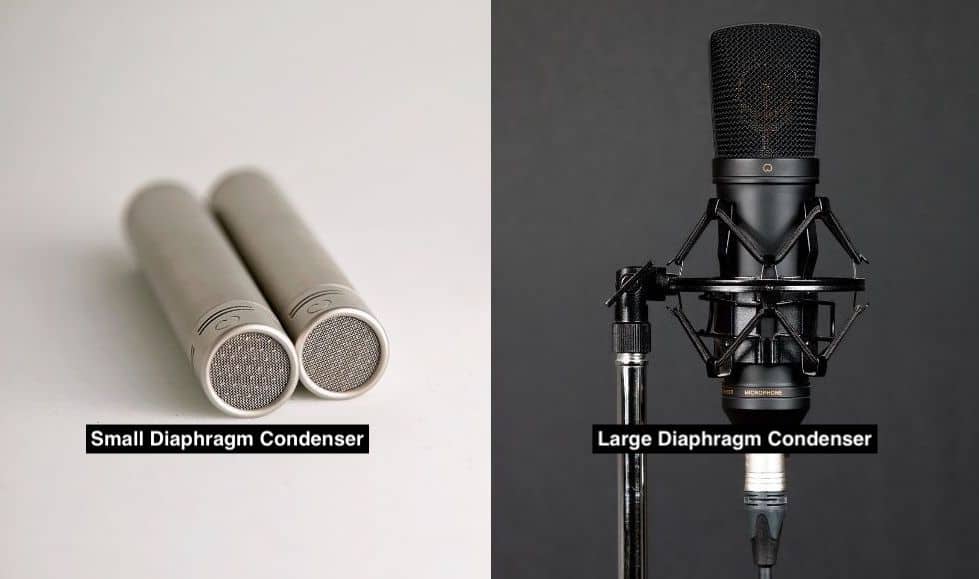
In other words, if you take a look at the small-diaphragm condenser, like the Audio Technica AT2021 for example, the actual microphone is at the end, which means you point it at the source of the sound to pick up the signal.
The large diaphragm, on the other hand, is not positioned in the same way. A large diaphragm is typically placed parallel to the source like what you can see in the following image.
When to Use a Large Diaphragm Condenser Microphone
For Vocals
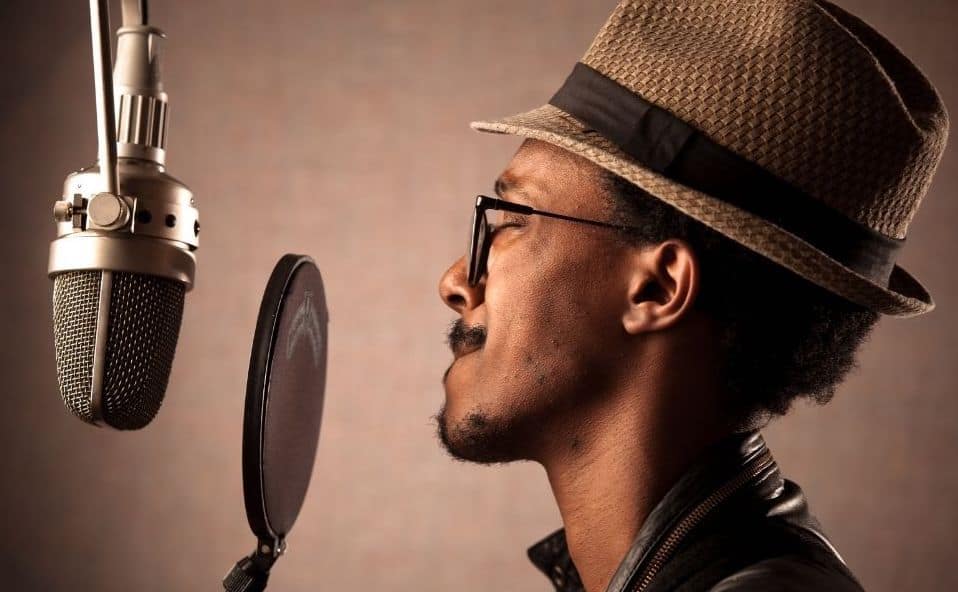
Because they’re more sensitive to sound pressure, condenser microphones are better at picking up details. One such example, and perhaps the most important one, is for vocals.
In popular music, the vocals are the most important part of the song, even more so than the instruments and soundscapes which make up the backbone of the recording.
It’s certainly possible to use a ribbon or a dynamic microphone for recording vocals – (and frankly, most people wouldn’t notice the difference between them) – but there’s no question that a condenser mic is the best option for vocals, especially the larger diaphragm microphone.
The reason for this is that we want to record the details, the nuances, and the intricacies of the singer’s voice, but more importantly, large-diaphragm mics are better at picking up the low-end frequencies.
According to Neuman, small-diaphragm condenser microphones are actually much better at picking up transients; they have a wider frequency response and they also have a more consistent polar pattern. In effect, they’re a superior mic, but there’s a specific reason why it’s best to use a large-diaphragm mic versus a small one.
One reason why it’s best to use a large-diaphragm mic instead of a small diaphragm is that large-diaphragm mics have a better noise performance. Additionally, their supposed “shortcomings” is precisely what makes them a great option for vocals.
For example, large-diaphragm mics, like the Audio Technica AT2035 (also on my Product Page), widen their pattern at low frequencies, which means their low-end frequency response is better for when the singer moves, which a vocalist commonly does in order to fully express themselves.
Additionally, singers often like the appearance of a large-diaphragm condenser mic because it gives them something to look at while singing.
Solo Acoustic Guitar
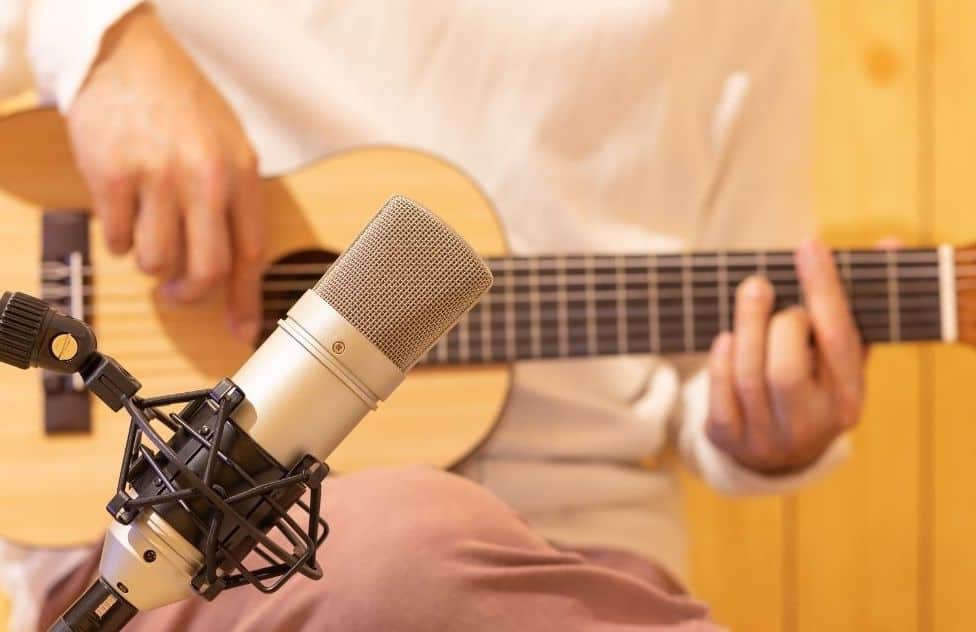
While it may be best to use a small-diaphragm condenser microphone for an acoustic guitar that isn’t the sole instrument in the recording, large-diaphragm condenser mics are better for recording a solo acoustic guitar. People like to use them when they want their solo instruments to sound bigger, thicker, more vibrant, or more alive.
Additionally, large-diaphragm condenser mics are known for adding a bit of flavour to the sound, which is one of the reasons why some people may prefer to actually use a small-diaphragm condenser microphone instead.
Small-diaphragm mics are really good at capturing the sound as it is; how it sounds naturally and without colouring it.
Acoustic Bass, Bass Guitar, Saxophones, Trumpet, Piano
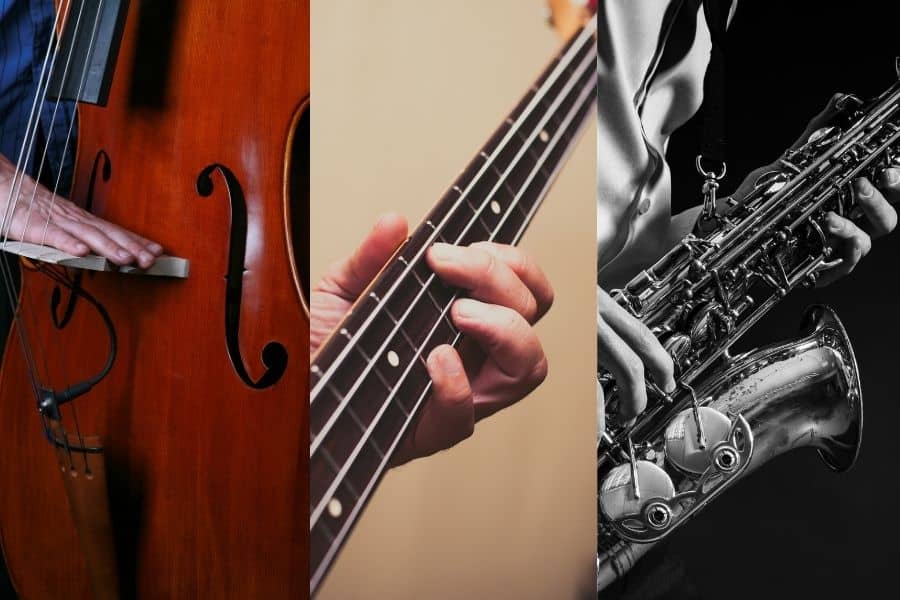
Because of their sensitivity, condenser microphones are excellent for higher-range frequencies and details. Small and large-diaphragm microphones, while they’re both excellent in this area, are slightly different from each other in the sense that larger diaphragm mics tend to be better at getting low-end.
This is one of the reasons they’re great for vocals, but also why they’re good for acoustic bass, trumpet, saxophone, the piano, and similar instruments. In many cases, the two condenser microphone types can be used interchangeably, so it’s not like it’s a hard-set rule that one has to be used over the other.
When to Use a Small Diaphragm Condenser Microphone
Acoustic Guitars
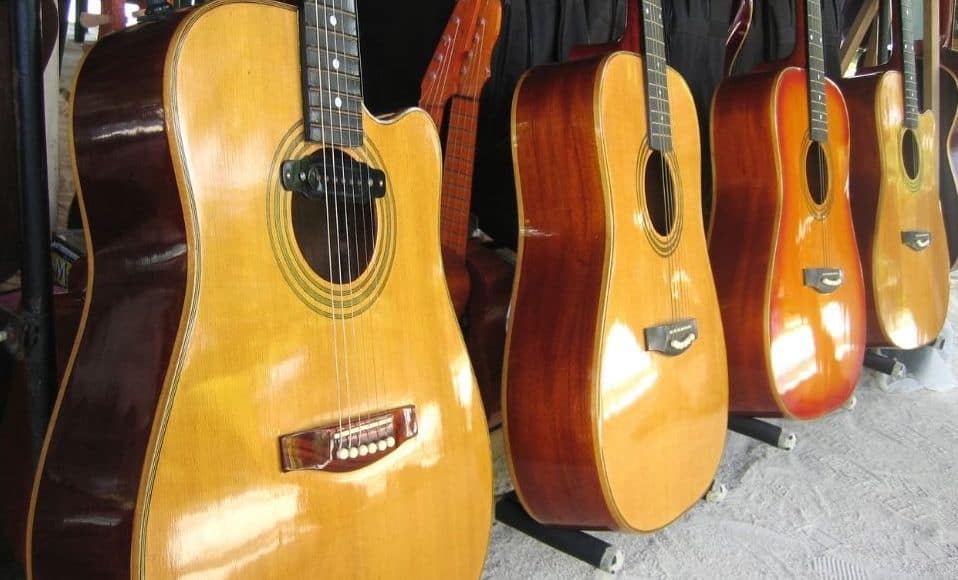
It seems like a bit of a contradiction to list acoustic guitars again, but hear me out. If you’re trying to capture the way the acoustic guitar sounds naturally, then the small-diaphragm condenser microphone is probably a good choice. The reason for this has to do with the superior transient response, which I already noted above.
A small-diaphragm condenser is more capable of picking up details in a way that doesn’t colour the sound, and as such, it’s a great choice for an acoustic guitar.
One example of why it’s a good option is because of the attack. Small-diaphragm condenser microphones are great for getting the pick attack and the other short bursts of energy.
In popular music, it’s not uncommon for sound engineers to mix acoustic guitars in such a way that the pick attack is much louder than the actual notes (which I’ve explained before in my article on compressing acoustic guitars).
If small-diaphragm condenser mics are better at picking up on the attack, it’s not hard to understand why then SDCs are chosen over large-diaphragm in the case of acoustic guitars being included as part of the performance, rather than the whole performance.
Furthermore, their wider frequency response means you’re going to get a more accurate depiction of the lows, the mids, and the highs.
Small diaphragm condensers are better for recording acoustic guitars when they are a part of the performance, and not the whole performance.
In other words, if there is more than one instrument, it’s probably best to use a small diaphragm. But if it’s just the guitar, then the large diaphragm condenser might be the best way to go.
Piano

For the same reasons mentioned earlier that make condenser mics a great option for acoustic guitars, small condenser microphones are good for the piano.
The piano is such a large and varied instrument, with the lowest of the lows and the highest of the highs. There are seven different octaves on the piano, which means you need a microphone that’s capable of capturing the lows, mids, and highs with the same amount of detail and balance.
Small diaphragm condensers have a smooth transient response, additionally, they’re much smaller, so it’s easier to place a couple of them around the piano wherever necessary.
More importantly, if you’ll recall what I said earlier, small diaphragms are pointed at the source of the sound, so micing a piano is easier with a small-diaphragm condenser (However, large-diaphragm microphones are often used for recording piano as well, especially if it’s the sole instrument in the recording).
Orchestral Instruments (Strings, Brass, Ensemble, Choirs, Bass)

According to Neumann, sound engineers who need equipment to record classical music and orchestral instruments, such as strings, brass, ensemble, choirs, and bass instruments, generally like to use small-diaphragm condensers because of their consistent pickup pattern.
Additionally, they’re known for being great at capturing stereo or even surround sounds.
Another reason why people like to use small-diaphragm condenser mics for orchestral instruments is that people who like this type of music generally like to hear the sound of the instruments as they are, rather than coloured by either something that happens in post-processing, mixing or with the mic itself.
In other words, small-diaphragm microphones, because they’re great at preserving the sound as it is in nature, are best for strings and other instruments where authenticity and its natural state are crucial to the listener.
Drum Overheads
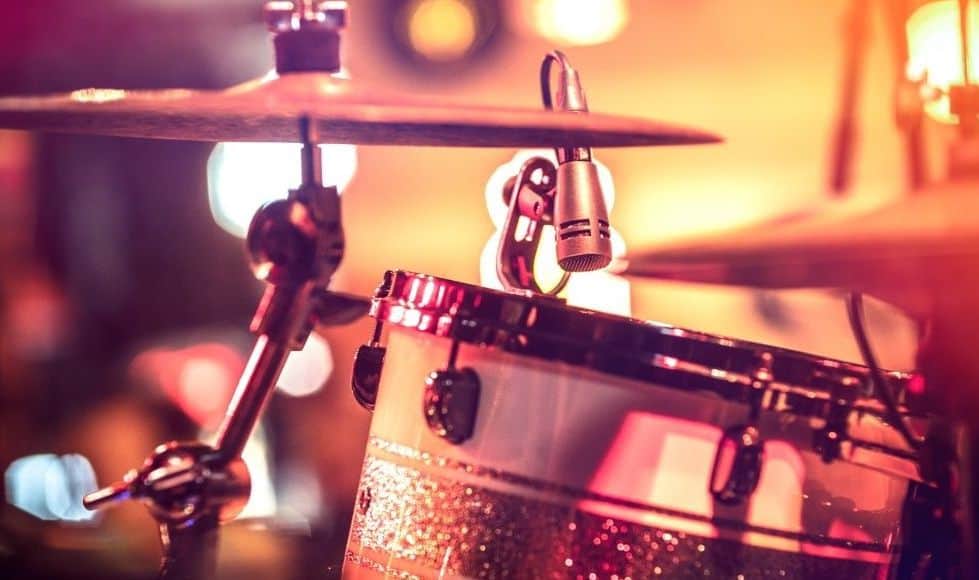
Small-diaphragm microphones are also most suited for drum overheads because of their transient response. If you just take a moment to think about it, a drum or an overhead is an instrument in which the player smashes a wooden stick against an object, producing the sound.
This is obviously a very explosive movement that leads to a short, strong, burst of energy, also called a transient. Small diaphragm condensers are great at capturing these bursts of energy and are commonly used for overheads for that reason.
Important Things to Note About Condenser Microphone Application
1) Condenser Mics Are Versatile
In this article and others out there, there is a lot of talks about which microphone is best used in one situation over another, however, I think it’s worth mentioning that a small diaphragm condenser mic can be used for pretty much any situation, and the same thing could be said for its larger counterpart.
For example, it wouldn’t be the worst thing in the world if you used a small-diaphragm microphone for your vocals.
Also, it’s great to use a small diaphragm condenser for a piano, but in other situations, you would want to use a large diaphragm, especially if the piano riff includes the lower octaves.
According to what I’ve read and what I’ve been taught, there is no hard-set rule when it comes to recording and producing (which I’ve already said but is worth re-stating).
YouTube Video Tutorial
Gear Mentioned in the Article
Both of these microphones are budget condenser mics, so they’re certainly not the best that money can buy. However, they are great value for the price and they’re an excellent introduction to condenser microphones, what they sound like, and how they’re used. Both links take you to Amazon.

 Written By :
Written By : 